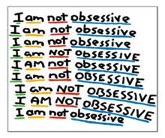Pursuing Values over Resolutions in the New Year
Jill Stoddard
by Jan E. Estrellado, Ph.D.
2016 has arrived! As we say good-bye to 2015, it’s time to look forward to setting intentions for the new year. Knowing that resolutions don’t always work out, what if we tried basing those intentions on our values rather than on our goals?
Image source: http://allisonpataki.com/set-new-years-resolutions-january/
The Problem with Resolutions
It seems that while many people make resolutions every year, only a few are able to maintain those changes. According to the Statistic Brain Research Institute (2015), 45% of people in the U.S. make resolutions, but only 8% of people successfully achieve them. In 2015, the top three resolutions for the new year were losing weight, getting organized, and spending less/saving more.
Why might it be so hard for us to accomplish the resolutions we set so hopefully at the beginning of each year? And perhaps more importantly, how do we deal with and recover from the guilt, anxiety, stress, and embarrassment that often come when we fail to meet these goals?
For some helpful answers, we might look to Acceptance and Commitment Therapy (ACT), an evidence-based intervention that, in the words of Happiness Trap author Russ Harris (2008), “helps people create a rich and meaningful life, while effectively handling the pain and stress that life inevitably brings.”
According to ACT (pronounced as one word), it is the struggle with “what’s wrong” in our lives that causes much of our suffering. We’ve all been there: the slice of chocolate cake we couldn’t resist, the day we chose to stay home instead of going to the gym, or spending more than we wanted to eating out. It is normal to feel ashamed, guilty, or frustrated with ourselves, often accompanied by thoughts of self-judgment and doubt (i.e., I have no self-control, I was doomed to fail from the start, etc.). It is so easy to spend time and energy beating ourselves up for what we should have done, that we end up in a worse place than when we started. How many of us have eaten that second slice of chocolate cake to soothe our guilt about eating the first one?
Values-Based Living
Image source: http://www.sanitygurus.com/relaxation/
In contrast to resolutions, values are never finished. Think of values as the direction you are headed in (“westward”) versus a destination west of you (“Hawai’i”). One can continue on in that direction indefinitely and it will never be done. It is a series of choices we make over and over again to carve out a path in the direction of that value.
What might values-based living look like as an alternative to New Year’s resolutions? Let’s take the #1 resolution of 2015: losing weight. Why might losing weight be important to you? Do you want to feel good in your body, to invest in your physical health, to live longer for your family or to model healthy behaviors to your children? Clarifying why we choose a goal might be more important than the goal itself. For example, if I want to live long enough to see my kids grow up, my choices might focus more on being active with my kids and less on counting calories. I may or may not lose weight, but keeping my choices and behaviors aligned with my greater value moves me toward the person I would like to be.
Acting in service of our values does not mean that the path will be easy or comfortable. In fact, choosing our values means that we also choose the pain that will inevitably come. Living from our values means we accept that painful and unwanted outcomes sometimes happen. Staying the values-based course as the painful stuff happens is what gives us meaning and purpose.
Are you willing to give values a try this year?
CSAM is here to help
If you or someone you love might benefit from acceptance and commitment therapy (ACT), cognitive behavioral therapy (CBT), or biofeedback for anxiety, depression, stress, or a chronic medical illness, or if you would like more information about our therapy services, please contact us at (858) 354-4077 or at csamsandiego@gmail.com.
References:
Statistics Brain Research Institute (2015). New years resolution statistics. Retrieved from http://www.statisticbrain.com/new-years-resolution-statistics/
Harris, R. (2008). What is acceptance and commitment therapy? Retrieved from http://www.thehappinesstrap.com/about_act










